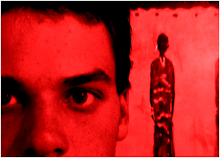Upon the barren
dust-strewn killing fields, the fool shrieks skywards, accusing the Gods and
Buddha’s for mankind’s vicious plight! Although bereft of the poetic grandeur
of old English speech, the climax of Akira Kurosawa’s adaptation of
Shakespeare’s King Lear , Ran, still
carries across the theatrical vastness of the source material, whilst fusing it
with a new ‘simplicity’. Trading the setting from the dark ages of Britain to
Feudal Japan is one primary reason for this shift from the eloquence of the spoken
word to the versatility of the camera. But perhaps the most pleasing reason is
that due to the fact that Shakespears plays have been adapted in myriad ways, usually
retaining the same iconic dialog, Kurosawa chooses to change the perspective to
exemplifying scenery and scale to capture the source dialog in a ‘muted’
fashion. In other words, ‘showing’ rather than ‘telling’.
The same can be
said (aside from the role of colour) for Kurosawas Throne of Blood, which is a
samurai cantered adaptation of Macbeth.
The prominent use of ‘symmetry’, with the protagonist at the centre of
the frame, is used to epitomise the protagonists (Lord Hidetora in Ran and
Washizu in Throne of Blood both played superbly by Toshiro Mifune) isolation
which is only intensified by the ‘tangled web’ of murder and deception that
they weave. The scene in Throne of Blood, in which the Lord Washizu has stabbed
his messenger, is almost mirrored in Ran when Lord Hidetora leaves his son’s
castle, shutting the gates behind him.
Along with the use symmetry used to ‘mute’ out the
Shakespearian dialog, the presentation of violence is also presented in an
eloquently ‘chaotic’ fashion. In Ran, we see this in the scene in which Lord
Hidetora is besieged within his new castle by the armies of his two sons.
Kurosawa described this scene as
“ ...A terrible scroll of Hell is shown depicting the fall of the castle. There are no real sounds as the scroll unfolds like a daytime nightmare. It is a scene of human evil doing, the way of the demonic Ashura, as seen by a Buddha in tears. The music superimposed on these pictures is, like the Buddha's heart, measured in beats of profound anguish, the chanting of a melody full of sorrow that begins like sobbing and rises gradually as it is repeated, like karmic cycles, then finally sounds like the wailing of countless Buddhas.”
The musical montage
of dread images enthuses Shakespeare drama not only with a sense of the
contemporary operatic , but also with the kind of quick-paced patchwork of
grizzly scenes that is evident in Eisenstein’s Odessa Steps sequence in
Battleship Potemkin.
In Throne of Blood,
the presentation of muted violence epitomizing the Shakespearian is the films
bloody climax, when Washizu is riddled with arrows by his own men. This scene
is also distinguishably operatic, and the more discerning viewer may link this
scene swiftly with Tony Montana’s last stand in Brian De Palma’s Scarface.
